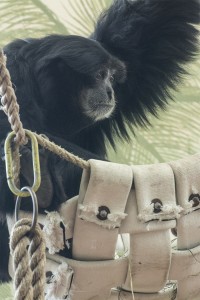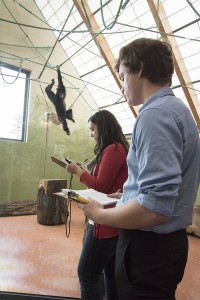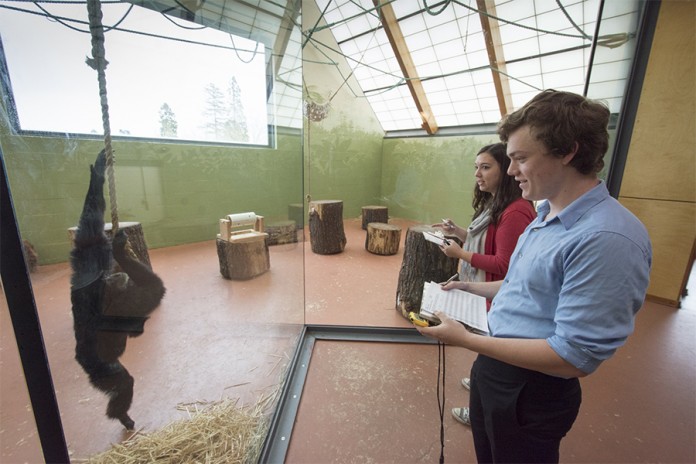Submitted by University of Puget Sound
 If you’re a fun-loving gibbon, there’s nothing quite like having a truly dedicated audience—someone to admire your incredible skills, your intelligence, and your handsome style on the ropes.
If you’re a fun-loving gibbon, there’s nothing quite like having a truly dedicated audience—someone to admire your incredible skills, your intelligence, and your handsome style on the ropes.
And this spring there was no audience more dedicated than the 16 University of Puget Sound biology students who spent hours at Point Defiance Zoo & Aquarium with the resident siamangs and white-cheeked gibbons. With their focused stares, clipboards, and stopwatches, the students gave the proud primates a full measure of the celebrity they deserve.
Working under the direction of Puget Sound Professor of Biology Stacey Weiss and the zoo’s Senior Staff Biologist Paul Povey, the biology students were studying what difference a richly stimulating zoo environment can make to animals.
They decided to design two new toys: a ceiling-suspended swinging toy, with small holes and baskets containing food for the gibbons; and a spinning food toy mounted to a log on the floor for the siamangs (a type of large gibbon with a prominent vocal sac). The students wanted to record exactly how the primates would react—in terms of how much they engaged in play and with each other— when their environment was enriched with a new and challenging toy.
“Modern zoos are putting more and more effort into enriching the environment of the animals in their care and high standards are required for accreditation,” said Weiss. “By working with the zoo on this project, our students are taking a leadership role in adding to a growing body of knowledge about this topic.”
Zoo General Curator Karen Goodrowe Beck added, “Point Defiance Zoo & Aquarium and University of Puget Sound have a longstanding partnership that encompasses almost a decade of students coming to the zoo for observations and study. This partnership has helped us understand what enrichments animals prefer. And it has helped us better understand how animals use their exhibits.”
 The students visited in pairs, several times a week, to quietly and unobtrusively observe the animals’ behavior. On some days the zoo staff installed the novel toy, and on other days, the novel toy was removed to test the primates’ reaction. An older, familiar toy, one frequently used to engage the animals, was available at all times.
The students visited in pairs, several times a week, to quietly and unobtrusively observe the animals’ behavior. On some days the zoo staff installed the novel toy, and on other days, the novel toy was removed to test the primates’ reaction. An older, familiar toy, one frequently used to engage the animals, was available at all times.
The students worked in teams of eight, with each team observing a pair of male and female siamangs or gibbons. Across the two studies, the pairs of visiting students made 40 one-hour observations over the course of a semester for a total of 80 man-hours of research.
And the result? The students deemed it a success. For the gibbons, who experienced the toy hung from the ceiling, both the male and female spent more time swinging on ropes or sitting on upper ledges when the hanging toy was present. The female appeared more excited by the novel toy and was much more likely to play with it than the male.
For the siamangs, whose toy sat on a log on the ground and spat out food when the animals spun it around, the siamang pair spent more time on the ground when the toy was present. The male and female siamangs also spent more time together or near each other when the toy was present. In this case, it was the male who seemed more adventurous and who played more often with the novel toy. The female was more likely to play with her older, familiar toy.
“This was a compelling result for the students to discover,” Weiss said. “The data suggest that novelty in the environment does provide a healthy, new diversion for animals. Interestingly, they not only chose to engage in play with the toy or to be near it, but in the case of the siamangs, it seemed to stimulate a fresh interest in being with each other.”
Students are preparing their data in poster format for submission to the zoo and will be giving an oral presentation of their work to the zoo staff on May 12. Biology is one of the more popular majors at University of Puget Sound, paving the way for graduate school studies; professional work in the health sciences or teaching; or, in some cases, for jobs and careers at Point Defiance Zoo & Aquarium.
All photos courtesy of Ross Mulhausen, University of Puget Sound.













































